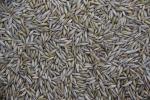Biodiversity Foundation Project: Divergent responses to global warming in the biodiversity of cereal agroecosystems
- Type Project
- Execution 2017 -2018
- Scope Europeo
- Main source of financing Biodiversity Foundation
- Project website Web proyecto (Fundación Biodiversidad)
The project "Divergent responses to global warming in the biodiversity of agroecosystems. Search for weed species that are indicators of climate change," launched by the National Institute of Agricultural and Food Research and Technology (INIA), aims to assess the effect of climate change on the diversity of weed species present in cereal-producing agroecosystems in the central-southern Iberian Peninsula. The initiative is supported by the Biodiversity Foundation. In general, biodiversity monitoring is a means of obtaining information on the state of the ecosystem and its dynamics of change in relation to human activities within an area.
It is based on the regular observation of potential changes in previously agreed-upon variables over a specific time and area, and their subsequent evaluation. Within this framework, the implementation of a weed species monitoring program in cereal agroecosystems in the area under study (southern-central region of the Iberian Peninsula) contributes to the detection of changes.
The knowledge generated about the presence of weed species in the different latitudes studied allows for adequate management of the impact that changes in environmental variables can produce, so that it can be avoided and/or minimized, while ensuring that management measures are effective.
The geographical location of weed species, more or less thermophilic, in cereal agro-ecosystems contributes to the detection of temperature changes that may occur in these systems at a regional or local scale.
To assess the effect of climate change on the diversity of weed species present in cereal agroecosystems in the south-central Iberian Peninsula.
General conclusions of this project:
- Climate change influences the pressure that weeds exert on agro-ecosystems.
- The ecosystem services provided by weeds in cereal agroecosystems may be compromised by climate change.
- Weeds can be an indicator of a change in environmental conditions.
- Requirements have been established to consider a weed as potentially indicative of a change in climatic conditions.
- Geographic distribution patterns of temperature-sensitive weeds can facilitate the design of new weed management strategies in future global change scenarios.







